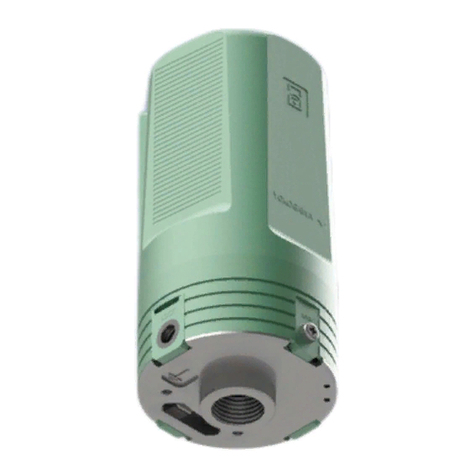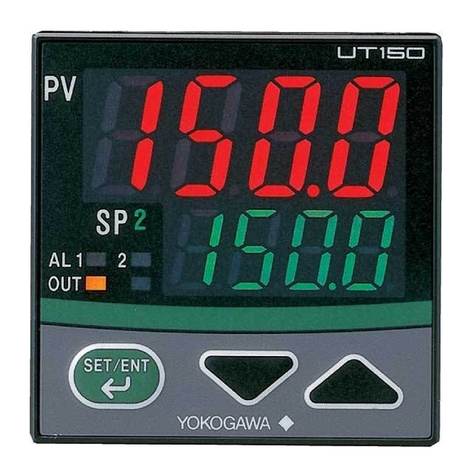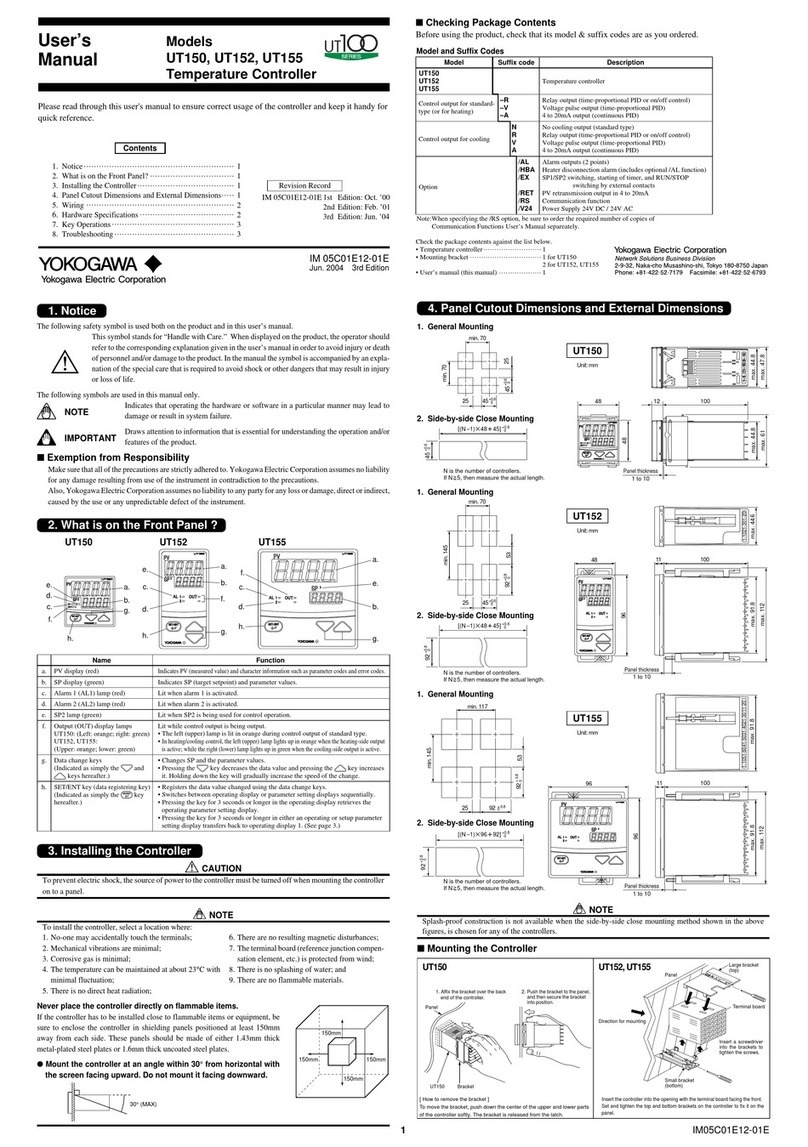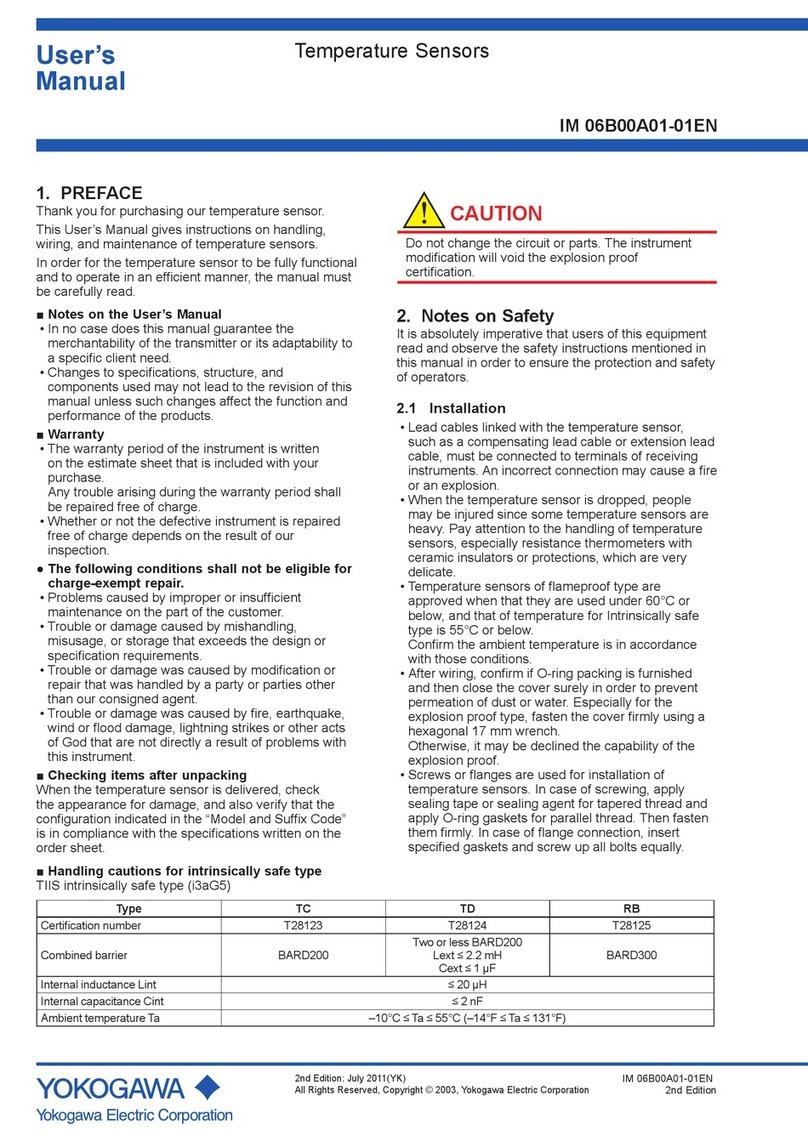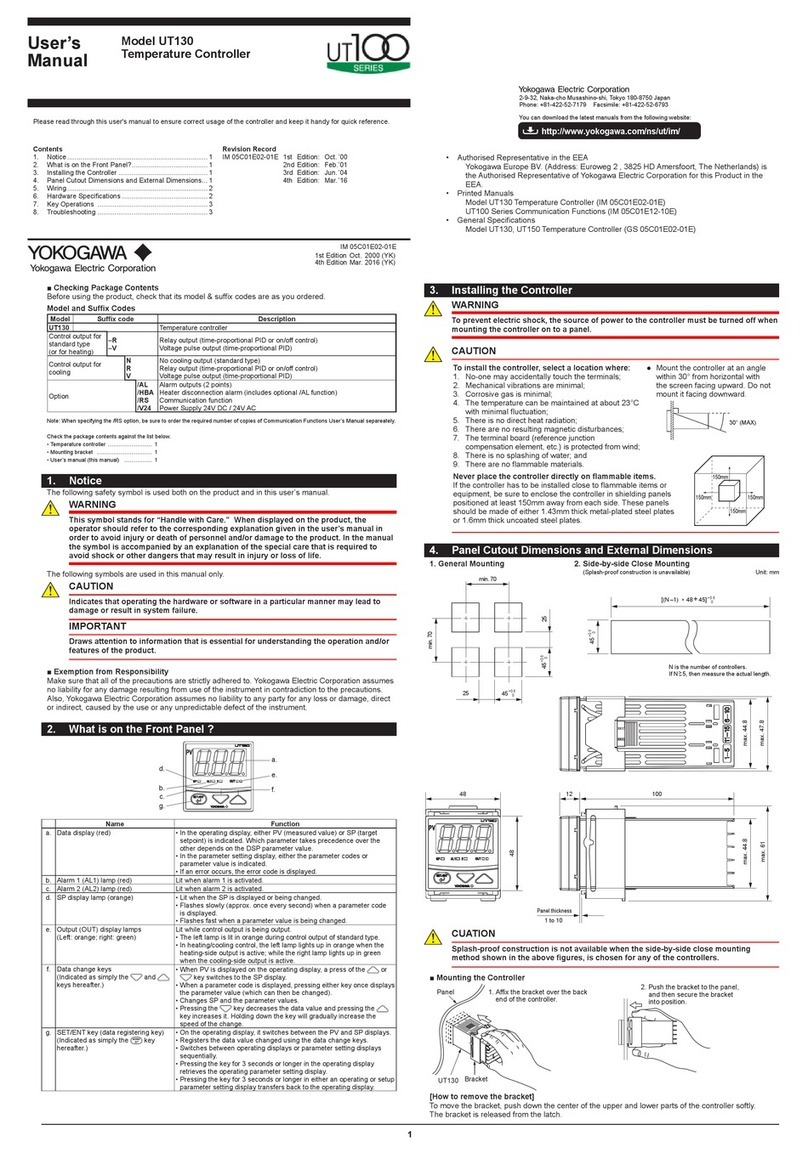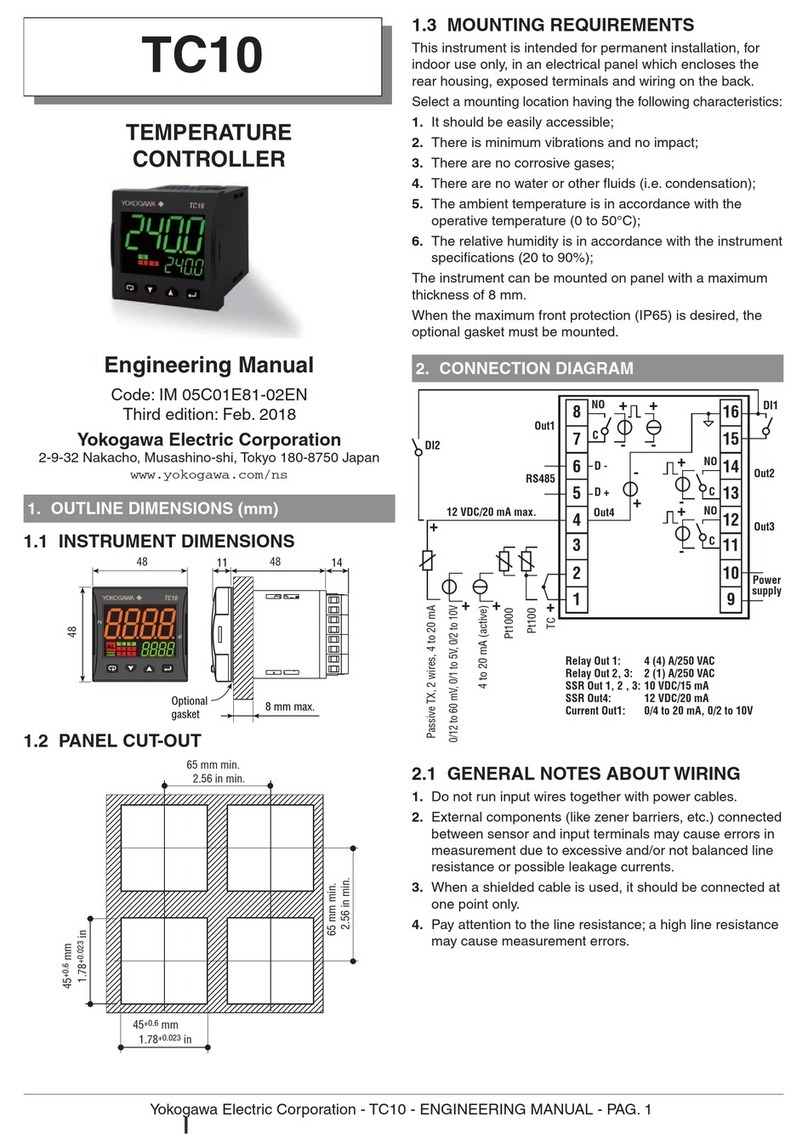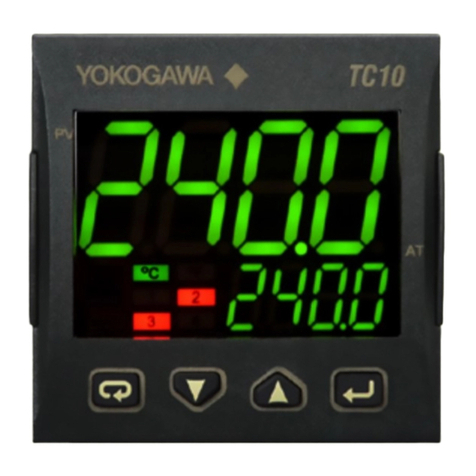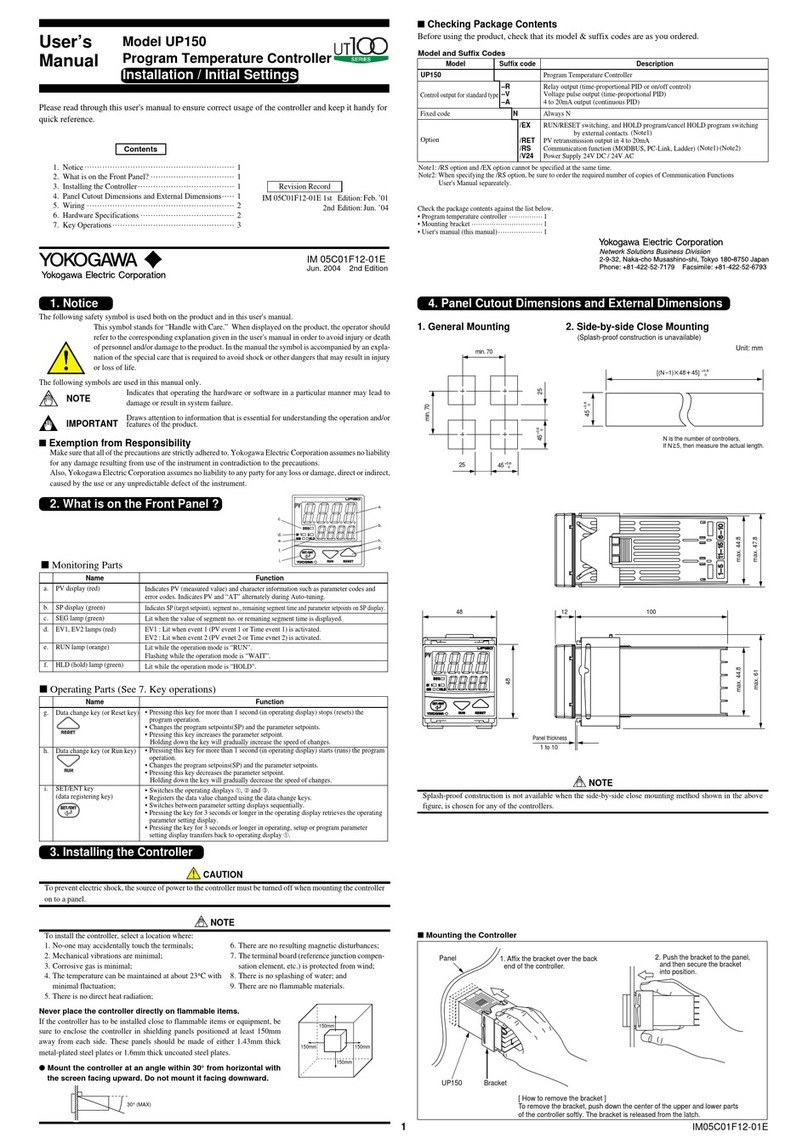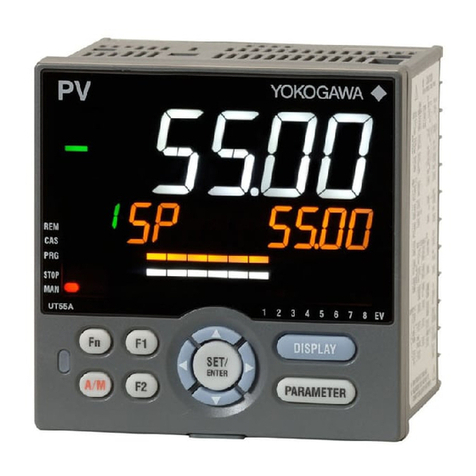
IM05C01F12-01E 3rd Edition Feb. 29, 2016-00
2
Measured Value (PV) Input
●Input: 1 point
●Input type: Universal; can be selected by software
●Input accuracy (at 23 ±2°C ambient temperature)
●Thermocouple:±2°C±1digit
However,
• ±4°C for thermocouple input –270 to –100°C
• ±3°C for thermocouple input –100 to 0°C
• ±5°C for types R and S (±9°C for 0 to 500°C)
• ±9°C for type B (accuracy is not guaranteed
for 0 to 400°C)
●RTD:±1°C±1digit
●Voltage(mV,V):±0.3%±1digit
●Sampling period for measured value input: 500ms
●
Burn-out detection: Functions for thermocouple or RTD input
(burn-out upscale only; cannot be switched off)
●Inputresistance:1MΩorgreaterforthermocouple
orDCmVinput.Approx.1MΩforDCVinput
●Maximum allowable signal source resistance :
250ΩforthermocoupleorDCmVinput
2kΩforDCVinput
●
Maximum allowable wiring resistance for RTD input:
10Ω/wire(Theresistancevaluesofthreewires
must be the same.)
●
Allowable input voltage:
±10V DC for thermocouple or DC mV input
±20V DC for DC V input
●
Noise rejection ratio:
Normal mode noise: Min. 40dB
(50/60Hz)
Common mode noise: Min. 120dB
(Min. 90dB for DC V input)
●Error of reference junction compensation:
±1.5°C (at 15-35°C), ±2.0°C (at 0-50°C)
The reference junction compensation cannot be
switched off.
●Applicable standards:
Thermocouple and resistance temperature
detector (RTD)
JIS/IEC/DIN (ITS90)
Contact Inputs
The contact inputs are provided only when the /EX
optionisspecied.
●Functions: (1) HOLD/Cancel HOLD switching
(2) RUN/RESET switching
●Input: 2 points (with the shared common terminal)
●Input type: Non-voltage contact or transistor
contact input
●Contact capacity: At least 12V/10mA
●On/offjudgment:Onstatefor1kΩorless;offstate
for20kΩorgreater
Control Output
●Output: 1 point
●Output type: Choose one from (1) to (3) below:
(1) Relay contact output
Contact capacity: 3A at 240V AC or 3A at 30V DC
(with resistance load)
Note: The control output relay cannot be replaced
by users.
(2) Voltage pulse output
On
voltage: 12-18V DC
Off
voltage: 0.1V DC or less
loadresistance:600Ωorgreater
short-circuit current: approx. 30mA
(3) Current output
Output signal: 4 to 20mA
Maximumloadresistance:600Ω
Outputaccuracy:±0.3%ofspan
(at 23±2°C ambient temperature)
Event Functions
PV Event Functions
●PV event types: 10 types
●PV high limit, PV low limit, Deviation high limit,
Deviation low limit, De-energized on deviation high
limit, De-energized on deviation low limit, Deviation
high and low limits, Deviation within high and low
limits, De-energized on PV high limit, De-energized
on PV low limit
Time Event Functions
The time event function begins countdown when
a program operation starts, and after the elapse
of a preset time, outputs an on-time event signal
(contact output: ON) or off-time event signal
(contact output: OFF).
●PV and Time event outputs: 2 relay contacts
Relay contact capacity: 1A at 240V AC or
1A at 30V DC
(with resistance load)
(COM terminal is common)
Note: The PV and time event output relays cannot
be replaced by users.
Retransmission Output
±2%ofprogramtime
Retransmission Output
The retransmission output is provided only when the
/REToptionisspecied.
●Output signal: Measured value in 4-20mA DC, can
be scaled.
●Maximumloadresistance:600Ω
●Outputaccuracy:±0.3%ofspan
(at 23±2°C ambient temperature)
Communication Function
The communication function is provided only when
the/RSoptionisspecied.(Fordetails,readthe
user's manual of the communications functions IM
05C01E12-10E.)
Communication Protocol
●Personal computer link: Used for communication
with a personal computer, or UT link module of
the FA-M3 controller (from Yokogawa Electric
Corporation).
●Ladder communication: Used for communication
with a ladder communication module of the FA-
M3, or a programmable controller (PLC) of other
manufacturers.
●MODBUS communication: Used for communication
with equipment featuring the MODBUS protocol.
Communication Interface
●Applicable standards: Complies with EIA RS-485
●
Number of controllers that can be connected: Up to 31
●Maximum communication distance: 1,200m
●Communication method: Two-wire half-duplex,
start-stop synchronization, non-procedural
●Baud rate: 2400, 4800, or 9600 bps
Safety and EMC Standards
WARNING
This instrument is classied into the
Measurement Category No.1 in the
following table.
Do not use for the measurements in
locations where the categories are
No.2, No.3, and No.4.
Internal Wiring
Outlet
IV III
O(I)
TII
●
Safety: Compliant with IEC/EN 61010-1 (CE), IEC/
EN 61010-2-201 (CE), IEC/EN 61010-2-030 (CE),
approved by CAN/CSA C22.2 No. 61010-1 (CSA),
approved by UL 61010-1.
Installation category: II
Pollution degree: 2
Measurement category: I (CAT I) (UL, CSA)
O (Other) (CE)
Rated measurement input voltage: Max. 10 V DC
Rated transient overvoltage: 1500 V (*)
* This is a reference safety standard value for
measurement category I of CSA/UL 61010-1,
and for measurement category O of IEC/EN
61010-2-030. This value is not necessarily a
guarantee of instrument performance.
●EMC standards: Complies with EN 61326.
The instrument continues to operate at a measuring
accuracyofwithin±20%oftherangeduringtests.
●KC marking: Electromagnetic wave interference
prevention standard, electromagnetic wave
protection standard compliance
No.
IEC/EN/CSA/
UL 61010-1
EN 61010-
2-030 Description
No.1 Measurement
Category I O (Other)
For measurements
performed on circuits not
directly connected to MAINS.
No.2 Measurement
Category II
Measurement
Category II
For measurements
performed on circuits
directly connected to the
low voltage installation.
No.3 Measurement
Category III
Measurement
Category III
For measurements
performed in the
building installation.
No.4 Measurement
Category IV
Measurement
Category IV
For measurements
performed at the source of
the low-voltage installation.
Power Supply and Isolation
CUATION
Caution to comply with EMC Standards:
When operating this instrument by external
power supply, use an independent power
unit conforming to CE marking.
Power Supply
Power
supply
Voltage
Ratedat100-240VAC(±10%)
AC/DC 24V, 20 to 29V of
allowable range when
"/V24"isspecied.
Frequency 50 or 60Hz
Maximum power
consumption
8VA max. (4W max.)
3W max. when
"/V24"isspecied.
Memory Non-volatile memory
Withstanding
voltage
Between primary
terminals and
secondary terminals
(See Notes 1 and 3.)
CE: 3000 V AC for 1 minute
(Between relay terminals
and secondary terminals
1500 V AC for 1 minute)
UL/CSA: 1500 V AC for 1
minute (Note 2)
Insulation
resistance
Between primary
terminals and
secondary terminals
(See Notes 1 and 3.)
20MΩormoreat
500V DC
Note 1:
The primary terminals are the power supply
terminals and event output terminals.
The secondary terminals are the analog input
and output terminals, the voltage pulse output
terminals, and the contact input terminals.
Note 2:
Thewithstandingvoltageisspeciedas2300
V AC per minute to provide a margin of safety.
Note 3:
AC/DC 24V terminals are secondary terminals.
Isolation
The bold lines below indicate reinforced isolation,
and the broken line indicates functional isolation.
In case of CE conformity, alternate long and short
dash line indicates basic insulation.
•Measured value input
terminals
•2 input terminals
for /EX
•Internal circuit
•
Control output
terminals
(relay contacts)
•
Event output
terminals
(2 relay contacts)
•
Control output terminals:
4-20 mA/Voltage pulse
•
Retransmission output terminals:
4-20 mA
•RS-485 terminals
for /RS
•Power supply
terminals
(100-240V AC)
•Power supply
terminals AC/DC 24V
(When “/V24” is specified)
Reinforced insulation
Functional insulation
In case of CE conformity,
alternate long and short dash
line indicates basic insulation.
Note:
Neither the measured value input terminals, nor 2
input terminals for the /EX option are isolated from
the internal circuit.
Construction, Mounting, and Wiring
●Construction: Dust-proof and drip-proof front panel
conforming to IP65.
For side-by-side close installation the controller
loses its dust-proof and drip-proof protection.
●Casing: ABS resin and polycarbonate
●Case color: Black
●Weight: approx. 200g
●Mounting: Flush panel mounting
●Wiring: Screw terminals
Environmental Conditions
Normal Operating Conditions
●Warm-up time: At least 30 minutes
●Ambient temperature:0-50°C (0-40°C when
mounted side-by-side)
●Rate of change of temperature: 10°C/h or less
●
Ambienthumidity:20-90%RH(nocondensationallowed)
●Magneticeld:400A/morless
●Continuous vibrations of 5 to 14Hz: Amplitude of
1.2mm or less
●Continuous vibrations of 14 to 150Hz: 4.9m/s2
(0.5G) or less
●Short-period vibrations: 14.7m/s2(1.5G) for 15
seconds or less
●Shock: 98m/s2(10G) for 11 milliseconds or less
●Mounting angle: Upward incline of up to 30
degrees; downward incline is not allowed.
●Altitude: 2000m or less above sea level
Maximum Effects from Operating Conditions
(1) Temperature effects
●Thermocouple,DCmVandDCVinput:±2μV/°C
or±0.02%ofF.S./°C,whicheverislarger
●Resistance temperature detector: ±0.05°C/°C
●Analogoutput:±0.05%ofF.S./°C
(2)Effectfromuctuationofpowersupplyvoltage
(within rated voltage range)
●Analoginput:±0.2μV/Vor±0.002%ofF.S./V,
whichever is larger
●Analogoutput:±0.05%ofF.S./V
Transportation and Storage Conditions
●Temperature: –25 to 70°C
●Humidity:5to95%RH(nocondensationallowed)
●Shock: Package drop height 90cm (when packed
in the dedicated package)
5. Wiring
WARNING
1) Before you start wiring, turn off the power source and use a tester to check that the controller and
cables are not receiving any power in order to prevent electric shock.
2) For safety, be sure to install a circuit breaker switch (of 5A and 100V AC or 220V AC, and that
conforms to IEC60947) near the instrument so as to be operated easily, and clearly indicate that
the device is used to de-energize the instrument.
3) Wiring should be carried out by personnel with appropriate electrical knowledge and experience.
4) For the wiring cable, the temperature rating is 60 °C or more.
CAUTION
1) Use a single-phase power source. If the source has a lot of noise, use an isolation transformer for
the primary side and a line lter (we recommend TDK’s ZAC2205-00U product) for the secondary
side. When this noise-prevention measure is taken, keep the primary and secondary power cables
well apart. Since the controller has no fuse, be sure to install a circuit breaker switch (of 5A and
100V AC or 220V AC, and that conforms to IEC standards) and clearly indicate that the device is
used to de-energize the controller.
2) For thermocouple input, use shielded compensating lead wires. For RTD input, use shielded wires
which have low resistance and no resistance difference between the 3 wires. See the table given
later for the specications of the cables and terminals and the recommended products.
3) The control output relay cannot be replaced even though it has a limited service life (100,000 relay
contacts for the resistance load). Thus, an auxiliary relay should be used so that the load can be
turned on and off.
4) When using an inductive load (L) such as an auxiliary relay and solenoid valve, be sure to insert
a CR lter (for AC) or diode (for DC) in parallel as a spark-rejecting surge suppressor to prevent
malfunctions or damage to the relay.
5) When there is the possibility of being struck by external lightening surge, use the arrester to
protect the instrument.
IMPORTANT
Always x a terminal cover bracket to the UP150 controller before wiring if an optional anti-electric-
shock terminal cover (part number: L4000FB) is used.
●Cable Specifications and Recommended Products
Power supply and relay contact output 600V vinyl insulated wire/cable, JIS C3307, 0.9 to 2.0mm2
Thermocouple input Shielded compensating lead wire, JIS C1610
RTD input Shielded wire (3-wire), UL2482 (Hitachi cable)
Other signals Shielded wire
●Recommended Terminals
Use M3.5 screw-compatible crimp-on terminals with an insulating sleeve, as shown below.
7mm or less
6. Hardware Specications
CAUTION
Do not use unassigned terminals as relay terminals.
CAUTION
The and stand for the polarity for DC 24V
power supply.
WARNING
To prevent damage to the controller, never provide
100-240V AC power supply for power supply AC/DC
24V model (when “/V24” is specied).
1
2
3
4
5
6
7
8
9
10
11
12
13
14
15
EV2
EV1
COM
PV or Time Event Outputs
11
12
13
External Contact Inputs
3
4
5
RUN
HOLD HOLD program when DI=ON.
Cancel HOLD program when DI=OFF.
Starts program (RUN) when DI=ON.
Resets program (RESET) when DI=OFF.
COM
When “/EX” is specified.
Can be used when DIS parameter is ON.
4 to 20 mA Output
Voltage Pulse Output
Control Output
Specify one for the output signal type.
14
15
+
–
14
15
+
–
Relay Contact Output
14
15
NO
COM
RS-485
3
4
5
RSB(+)
RSA(–)
SG
When “/RS” is specified.
Standard Type (Models UP150-N)
Power Supply
9L
N
10
100-240V AC
9
10
AC/DC 24V
+
–
TC Input RTD Input
7
8
6
7
8
+
–
B
b
A
Universal input-selectable
input type
DC mV or V Input
7
8
+
–
Measured Value (PV) Input
When “/RET”
is specified.
PV Retransmission Output
+
–
1
2
4 to 20 mA DC
(model UP150-RN) (model UP150-AN)
(model UP150-VN)
when /V24 option is specifed.
7
8
Note: Connecting a 250 Ωresistor to the terminals is
optional.
Model: X010-250-2 (resistor with M3.5 crimp-on terminal
lugs)
*
When receiving 4-20 mA DC current signals,
set the PV input type to 1-5 V DC (setpoint “22”).
Receiving 4-20 mA DC Current
Signals with the Controller
250
Ω
4-20mA
-
+
If the power is turned on, when the RUN/RESET external
contact input is ON, the controller is in runnig state. But
Hold/Cancel hold external contact input is ON, the controller
is in cancelling state.
CAUTION
Safety Precaution in IEC61010-1
Since the insulation provided to between relay
output terminal and secondary terminal is
Reinforced insulation, the connected circuit
should use a safety voltage circuit to comply with
IEC61010-1. (Refer to the drawing below.)
This product
Basic
Secondary-
side
A safety
voltage circuit
